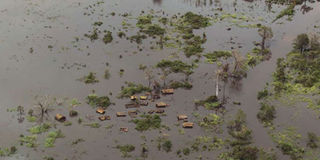How cyclones form and why climate change not linked to Idai

This handout picture taken and released on March 18, 2019, by the Mission Aviation Fellowship shows houses and flooding in an area affected by Cyclone Idai in Beira. PHOTO | RICK EMENAKET | MISSION AVIATION FELLOWSHIP | AFP
What you need to know:
- Several other cyclones have hit Mozambique and Madagascar before.
In February 2008, Cylone Ivan ripped through the Indian Ocean island of Madagascar with winds of over 200kmh, killing at least 26 people.
In March 2008, Cyclone Jokwe skimmed past northern Madagascar with winds at 160kmh, bring heavy rains to coastal Mozambique.
With more than a 1,000 people feared dead, according Mozambique President Filipe Nyusi, Cyclone Idai appears to be the worst storm to hit southern Africa in decades.
Several other cyclones have hit Mozambique and Madagascar before.
In February 2008, Cylone Ivan ripped through the Indian Ocean island of Madagascar with winds of over 200kmh, killing at least 26 people.
It devastated 45,000 acres of rice fields and left at least 14,000 homeless.
In the following month, Cyclone Jokwe skimmed past northern Madagascar with winds at 160kmh, bring heavy rains to coastal Mozambique.
In Mozambique, it left at least 16 people dead and affected 200,000 people.
THE SCIENCE
There has been fears that increasing temperatures may lead to more cyclones in coastal areas.
But a study conducted by Ms Jennifer M. Fitchett and Mr Stefan W. Grab in 2014 and published in the International Journal of Climatology did not find any evidence that rising temperatures could lead to increased frequency of tropical storms
The study, which focused on a 66-year tropical cyclone record for south-east Africa noted that number of tropical cyclone landfalls had decreased over time.
But the scientists noted an increasing trend of tropical storms in south-east Indian ocean, urging close monitoring of the storms across Mozambique.
"However, future tropical cyclone storm tracks across Mozambique should be closely monitored, as the increasing trend of such storms in this southeast Indian Ocean sector is consistent with increasing numbers of tropical cyclones making landfall over countries of similar longitude, adjacent to the northwest Indian Ocean," said the scientists, quoting a 2011 study on cyclones in northern Africa.
The scientists said continued work to improve understanding of cyclone landfalls is needed to improve early warning systems and projections.
HOW THEY FORM
Cyclones, also known as hurricanes or typhoons are the most violent storms in our planet. According to Nasa, only cyclones that form over the Atlantic Ocean or or eastern Pacific Ocean are called hurricanes. But they all form in the same manner.
The powerful storms, Nasa says, are like giant engines that use warm, moist air as fuel. They form near the equator as the warm, moist air over the ocean rises upward from near the surface, causing an area of lower air pressure below.
This forces surrounding areas with higher air pressure to push in to the low pressure area.
The new air also becomes warm and moist, consequently rising. The surrounding air swirls in to take its place. The warm air in the clouds cools off and the water in it forms clouds, a system of clouds.
The whole system of clouds and wind spins and grows and as it rotates faster and fast, eye forms in the centre.
When the winds rotating storm reach 39mph, the storm is called a tropical storm and they reach 74mph, it officially becomes a tropical cyclone or hurricane.
Cyclones typically weaken after making landfall but they often move far inland bring heavy rains and causing wind damage before dying out.





